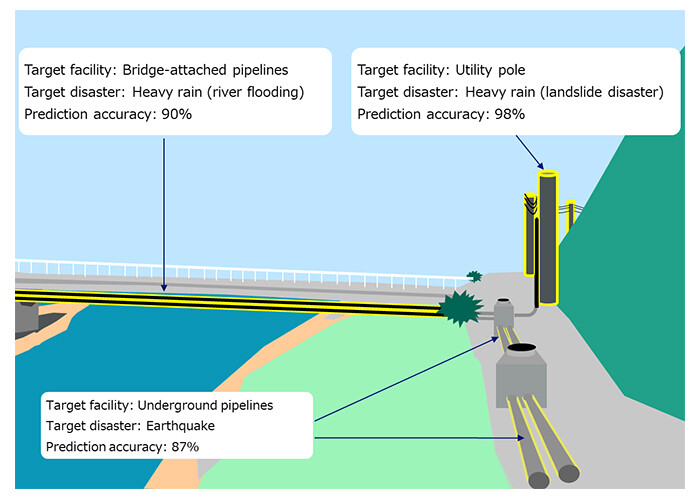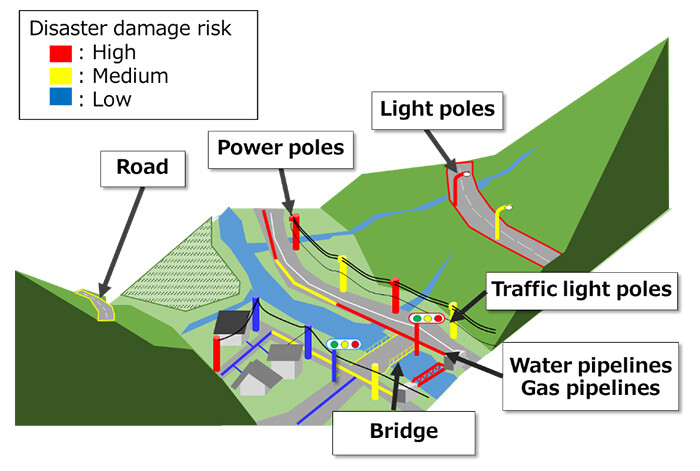Microsoft ends support for Internet Explorer on June 16, 2022.
We recommend using one of the browsers listed below.
- Microsoft Edge(Latest version)
- Mozilla Firefox(Latest version)
- Google Chrome(Latest version)
- Apple Safari(Latest version)
Please contact your browser provider for download and installation instructions.
April 25, 2024
NTT Corporation
Building an AI to predict infrastructure damage from disasters
Achieving infrastructure resilience and early disaster recovery
News Highlights:
- Using machine learning, we have built an AI that enables us to predict the damage to each facility due to disasters.
- This technology can predict damage regardless of the installation location without special field surveys, using publicly available data on topography, weather, and other factors.
- In the future, it is expected to be used for various social infrastructures such as supply pipes, utility poles, bridges, and roads.
Tokyo - April 25, 2024 - NTT Corporation (NTT) has developed for the first time a disaster prediction AI for individual facilities in outdoor communications infrastructure in the event of a disaster. This enables proactive responses necessary for disaster mitigation and early recovery. This technology allows for highly accurate disaster prediction by building a prediction model that learns disaster patterns from facility data that the NTT Group has inspected and repaired in the event of the past disasters. In addition, it can be predicted from publicly available data throughout Japan, making it possible to make predictions regardless of where the facility is installed. The results will be exhibited at the Tsukuba Forum 20241 from May 16-17, 2024. Based on this study, we aim to develop technologies to enable disaster damage prediction of social infrastructure.
1. Background
The infrastructure is built in consideration of disasters such as earthquakes and heavy rain, but it may be damaged in the event of a large-scale disaster. In particular, heavy rain disasters have become more severe in recent years, and there is a possibility that they could get worse. Proactive disaster mitigation and early recovery can be achieved by estimating the scale of the damage based on assumed seismic motions and early forecasts of rainfall and other factors, and by taking measures to prepare for the disaster in advance. To take these measures, it is important to predict the damage to facilities at the appropriate time. However, it was difficult to make a unified disaster prediction for each facility for the infrastructure widely distributed throughout Japan, because damage to facilities is intricately related to environmental conditions such as topography and ground, as well as the intensity of disasters such as rainfall and seismic motions.
2. Key points of the research results and the technologies
NTT has built an AI for disaster prediction that solves these problems by combining NTT Group's past data on damage to communications infrastructure in various regions with publicly available data on topography, weather, and other factors (Figure 1). This unique technology was developed by independently analyzing areas prone to damage using facility data from all over Japan. The three technologies we have established so far are shown in Figure 2. All these technologies have an accuracy rate of around 90% and can accurately predict damage to individual facilities throughout Japan without the special field surveys.
- Technology for predicting damage to utility poles by landslide disasters caused by heavy rain
This is a technology to predict which utility poles will be damaged by landslide disasters caused by heavy rain. In the past, to predict the landslide disaster itself, field surveys and simple statistical methods considering rainfall and slope angle have been used, but it has been difficult to make predictions for individual facilities. This technology can predict the damage risk of each utility pole using only publicly available data such as rainfall, elevation, ground strength, and distance from rivers. Moreover, it is possible to predict damage with a high accuracy of 98%. - Technology for predicting damage to bridge-attached pipeline caused by river flooding
This is a technology to predict which bridge-attached pipeline will be damaged by river flooding caused by heavy rain. In the past, it has been impossible to predict which facilities are likely to be damaged in the event of river flooding, but we have established a model that predicts which facilities are likely to be damaged by analyzing river data such as water level fluctuation and river width. It is a highly accurate prediction technology with 90% accuracy. - Technology for predicting damage to underground pipelines caused by earthquake
This is a technology to predict which underground pipelines will be damaged by an earthquake. In general, the number of damages per km of underground pipeline is estimated based on the type of pipeline, the peak ground velocity of an earthquake and other factors. This is a highly accurate prediction technology with 87% accuracy.
 Figure 1 Overview of Disaster Damage Prediction AI
Figure 1 Overview of Disaster Damage Prediction AI
 Figure 2 Established Disaster Damage Prediction Technology and Performance
Figure 2 Established Disaster Damage Prediction Technology and Performance
3. Outlook
By applying this technology to outdoor communications infrastructure and preparing facilities that are predicted to be at high risk of disaster before a disaster occurs, we will be able to reduce damages and recover quickly in the event of heavy rain or earthquake. For example, this technology will be used to reinforce pipelines that are at high risk of damage from anticipated seismic motion and to prepare materials necessary for restoration in advance of anticipated heavy rainfall. In addition, this technology can be applied not only to outdoor communication infrastructure but also to similar facilities. As shown in Figure 3, the technology for predicting damage to utility poles can be applied to power and signal poles, the technology for predicting damage to bridge-attached pipeline can be applied to the main bodies of bridges, and the technology for predicting damage to underground pipelines can be applied to underground facilities such as water and gas pipelines. By developing this technology, we aim to contribute to disaster damage mitigation and early recovery of the entire social infrastructure and toimprove the robustness of all infrastructure in Japan.
 Figure 3 Expected application of this Technology
Figure 3 Expected application of this Technology
1Tsukuba Forum 2024
https://www.tsukuba-forum.jp/e/index.html
About NTT
NTT contributes to a sustainable society through the power of innovation. We are a leading global technology company providing services to consumers and businesses as a mobile operator, infrastructure, networks, applications, and consulting provider. Our offerings include digital business consulting, managed application services, workplace and cloud solutions, data center and edge computing, all supported by our deep global industry expertise. We are over $97B in revenue and 330,000 employees, with $3.6B in annual R&D investments. Our operations span across 80+ countries and regions, allowing us to serve clients in over 190 of them. We serve over 75% of Fortune Global 100 companies, thousands of other enterprise and government clients and millions of consumers.
Media contact
NTT Information Network Laboratory Group
Public Relations
nttrd-pr@ml.ntt.com
Information is current as of the date of issue of the individual press release.
Please be advised that information may be outdated after that point.
NTT STORY
WEB media that thinks about the future with NTT










